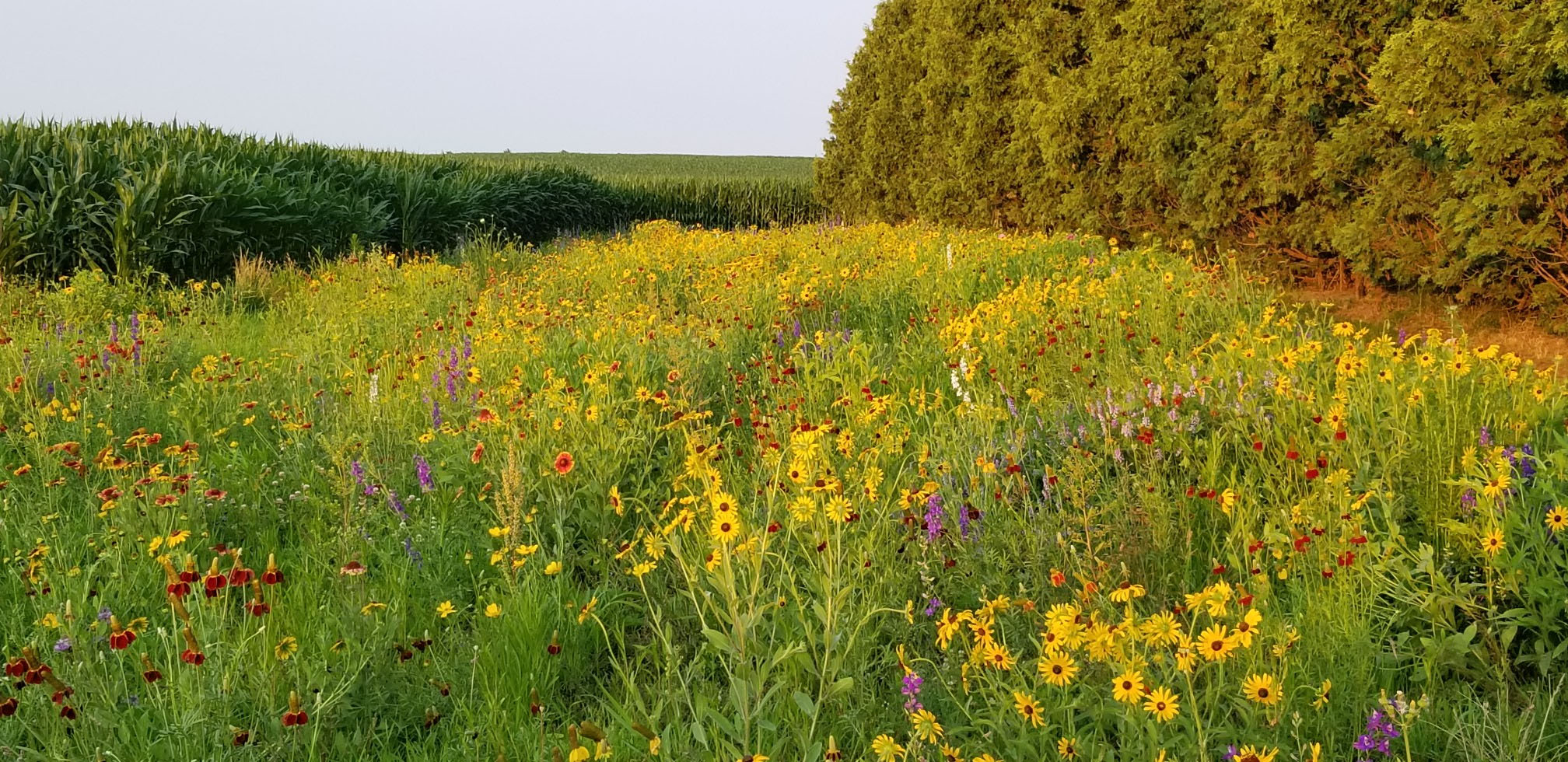
A native prairie garden is ideal for attracting pollinators. This third of an acre plot was planted in 2020 by Joe and Suzanne Shirbroun on some unproductive ground on their farm. (Photo: Suzanne Shirbroun)
Create a buzz by planting a pollinator garden this spring
April 21, 2022 | Kriss Nelson
Having a garden full of native plants is the “bee’s knees” when attracting pollinators. These plants produce nectar and pollen for bees, butterflies, birds and more.
Suzanne Shirbroun, Iowa Soybean Association (ISA) district 3 director and farmer from Farmersburg, and her husband Joe have taken their love for the outdoors to another level with two pollinator-habitat gardens.
“It’s great; Joe and I go out there in the evenings and see a different species bloom or emerge every few days,” says Shirbroun. “It’s fun to go out and identify plants, bees and monarchs.”
Taking advantage of areas on their farm no longer suitable for crop production, the Shirbrouns planted their first garden in the spring of 2020.
The third of an acre plot features close to 20 different types of species, including Plains Coreopsis, Lance-leaved Coreopsis, Indian Blanket, Prairie Cornflower, Big Leaf Lupine Cornflower, Wallflower and Hairy Vetch, to help attract pollinators and three different types of milkweeds for monarch butterflies.
Not only are milkweeds a source of nectar for monarch butterflies, but the milkweed leaves are the only food monarch caterpillars eat. Monarch butterflies lay their eggs on milkweed plants, so the caterpillars have access to food when they hatch.
The Shirbrouns had a firsthand account of this last year when they found a large volume of monarch larvae in their garden.
Last year, with assistance from ISA, the couple put nearly an acre into a wildflower garden to attract the Rusty Patched Bumblebee.
As part of an Endangered Species Pilot Project, ISA, along with Syngenta and other partners, is working with landowners on a native prairie restoration project to restore habitat for the Rusty Patched Bumblebee, which has been categorized as endangered by the U.S. Fish and Wildlife Service since 2017.
Brandon Iddings, field services program manager for conservation resources, is helping to facilitate the project, which is entering its third year.
Sites for the projects include priority zones established by the U.S. Fish and Wildlife service. Currently, Iddings says high priority zones include parts of Story, Boone and Jasper Counties, and areas in northeastern and east-central Iowa.
This year, there is a focus on establishing pollinator sites in Story County, where Iddings is looking for landowners to participate.
Iddings works with the landowners in choosing a site and says it is important to note he is not looking to take farm ground out of production.
“We might find a piece that isn’t as profitable,” he says. “This could be around grain bins or buildings, just areas you can’t farm.”
Iddings will hire a contractor to prepare the ground, which includes a kill down of the current growth and a fall drilling of seed.
For the next two years, the landowner must mow the site two to three times a year until the native plants are established and can out-compete the previous growth and weeds. During that transition, Iddings says he is available to advise when the cuttings should happen and to answer any questions.
It’s our “beeswax”
Iddings says pollinators are vital to various types of agriculture and help flowering plants to reproduce, and it is our job to bring native flowering plants back into our landscape.
Just about any flowering plant will do, but specifically, Iddings says Black-eyed Susan, Bee Balm, Asters, Coneflowers and Goldenrods, to name a few, seem to thrive well in Iowa’s environment. Native grasses such as switchgrass, Indian Grass, Little Blue Stem, and Big Blue Stem provide a place for bees, specifically the queen bee, to hibernate during the winter.
These native prairie restoration projects are also good habitats for other pollinator species and food and shelter for other wildlife.
With their farm’s location near a major state highway, Shirbroun says it is a perfect spot to show others their efforts.
“We want to show people farmers care about the environment,” she says. “We all have to do our part for pollinators.”
For more information on habitat restoration, contact Iddings at biddings@iasoybeans.com or 515-729-0039.
Back